 |
THE 2-OUT/3-IN OFFENSE
Many coaches such as Bob Knight and Steve Alford have found it advantageous to
run an offense that is physical in nature and allows for a limited number of
ball-handlers. This offense has been the 2-Out/3-In Offense. This
offense features three big men who are all adept at handling the basketball and
are capable of making plays within the structure of the offense. This
offense also works well with two guards who are capable of hitting big perimeter
shots and facilitating the big men within the framework of the offense.
Advantages of the 2-Out/3-In Offense
First, the offense is that of a physical nature. The three big men will
set screens that will wear down the defense over the course of the game.
This will become advantageous to us late in games and might even result in some
foul troubles for defenders who are looking to match the physicality of the
offense.
Second, the offense also allows for match-up advantages for the offense.
If you are playing a team that has post players who are not very good perimeter
defenders, the post players can take advantage. The offense puts bigs on
the perimeter playing defense when they are not accustomed to such a
requirement.
Finally, the 2-Out/3-In Offense can be run from either a three-around-two look
or a four-around-one look. This gives the offense a degree of flexibility
as to whether to run with two posts in the offense or to isolate the low post.
Disadvantages of the 2-Out/3-In Offense
The first big disadvantage of the 2-Out/3-In Offense is that it requires three
big men who are skilled enough to set screens, play facing the basket, and
posting up. The offense also requires a lot of breakdown time for it to
work effectively so that the offense can become mastered.
The other disadvantage is that if you have a play-making guard, this offense
will stifle his ability to create scoring opportunities for himself. The
offense works best when the guards work as feeders and the bigs work as the
playmakers.
Finally, the offense does not lend itself well to the fast break. As with
any other offense that is dominated by as many big men as this offense requires,
the fast break is not likely to occur with any degree of frequency. Teams
that employ this offense will want to avoid getting into high-scoring games and
instead focus on wearing down the opponent with the aggressive screening action
of this offense.
Three-Around-Two Look
There are two formations from which a team can run a
2-Out/3-In Offense. The first of these is the three around two
look shown in Diagram 1. This has the three inside players occupy
both low posts and the high post. The two guards, working as
feeders, position themselves at the wings.
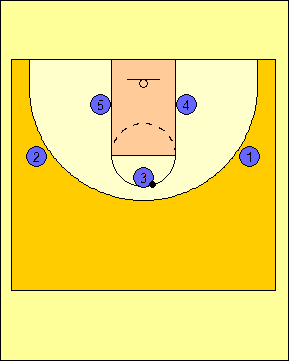
Diagram
1 |
There are a number of options that can be run when
the ball is passed to the wing. The first of these is to have
the ball-side low post position himself and work to get open as
shown in Diagram 2. While this is happening, the help-side low
post sets a back screen for the player in the high post. The
feeder can pass to either of the three with his looks being the
post-up, the cutter, and the screener in that order.
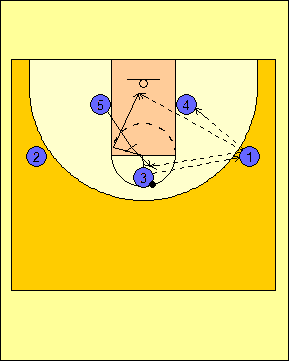
Diagram
2 |
Should this option not be available, another option is our screen-the-screener
option. In Diagram 3, the ball-side low post sets a cross screen for the
help-side low post. Once the cutter has come though on the cross screen,
the high post sets a down screen for the first screener.
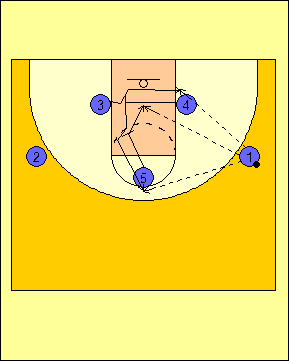
Diagram
3 |
If at any time the ball is entered into the low
post, our remaining post players have to know what to do. The
high post will dive just to the help side of the front of the rim
while the help-side low post will fill the high post area (Diagram
4).
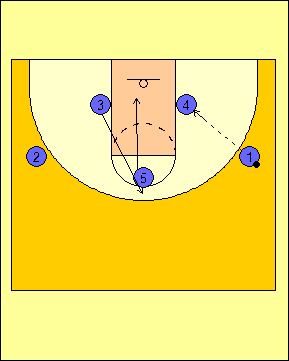
Diagram
4 |
The first pass look for the low post player with the
ball is to look to pass the ball to the big man cutting down the
lane (Diagram 5). If that pass is not available, there are
other options available with all of these being on the perimeter.
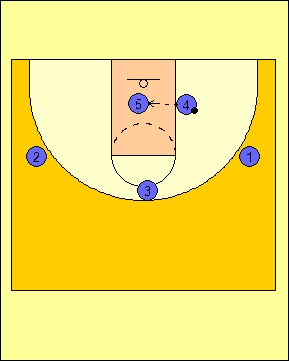
Diagram
5 |
If the ball is passed back out to the feeder who
made the initial post entry, we want to run the screen-the-screener
option (Diagram 6). This way, we can look to get the ball
right back inside to a different big man or we can reverse the
basketball much easier.
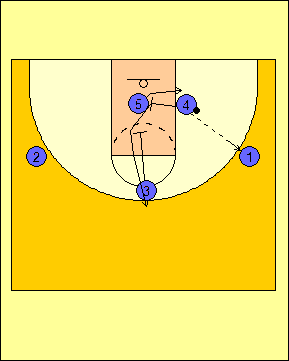
Diagram
6 |
The ball can also be passed back out to the point as
shown in Diagram 7. When this happens, both feeders will v-cut
and replace themselves. The high post can also look for the
high-low entry to the post who cut down the middle of the lane on
the post feed. If the ball gets swung from here, we want to
change sides of the floor. When that occurs, we will run the
screen-the-screener option shown in Diagram 8.
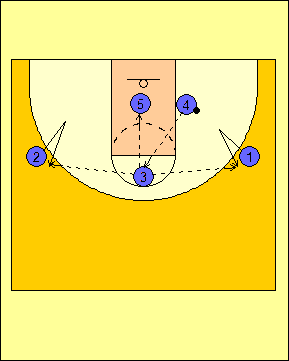
Diagram
7 |
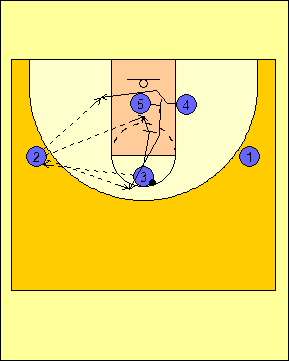
Diagram 8 |
The other perimeter pass that can be made is to the
help-side feeder (Diagram 9). When this play occurs, the dive
man will post up low and look for the basketball while the player
passing out of the post will set a back screen for the high post.
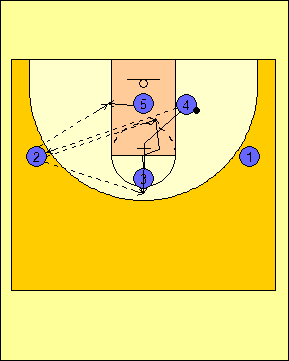
Diagram 9 |
If the ball is passed back to the high post at any
time, we look to get the guards involved and we work for the duck-in
with the other two bigs as shown in Diagram 10. When the pass
is made to the high post, both guards will v-cut and replace
themselves. Meanwhile, the player who was on the ball-side low
block will screen for the player situated at the other low post.
The high post will look for the cutter on the duck-in.
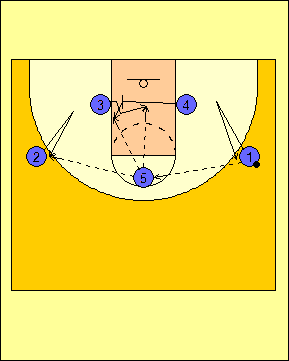
Diagram
10 |
Four Around One Look
Along with the three-around-two look, the
four-around-one look can also be used. This usually works best
when you want to have the opportunity to isolate one big man in the
low post. This can be dangerous for an offense that is looking
to double team the bigs with another big man.
Wildcat
The first offense from this alignment is one that
Kansas State ran at times when Frank Martin was their head coach.
We call this one "Wildcat". Here, the offense will get into a
four-around-one alignment and the three big men work together
looking to get the ball while there are two feeders working as
pressure release men (Diagram 11).

Diagram
11 |
There is an overriding rule in the offense when a
player in the high post makes an entry pass to the low post.
That rule is that the help-side high post player will dive to the
basket (Diagram 12). When this happens, the help-side feeder
will get in a position between the free throw line-extended and the
lane line-extended and look for the basketball. It is
important that the feeder stay behind the three-point line.
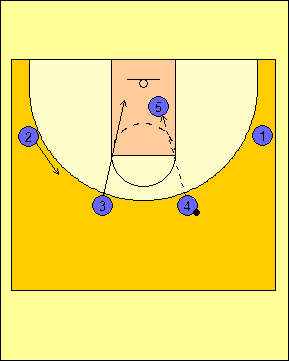
Diagram
12 |
In Wildcat, the low post has a two-second count to get the ball. If this
does not happen, the low post sets a back screen for the help-side high post as
shown in Diagram 13. Meanwhile, the ball-side feeder uses a v-cut and
replace to get open.

Diagram
13 |
After the ball is reversed, the action continues
with look inside for the low post for a count of two seconds
(Diagram 14). If not, we will look to get the back screen
going and either get the cutter for a lay-up or reverse the
basketball (Diagram 15).

Diagram
14 |
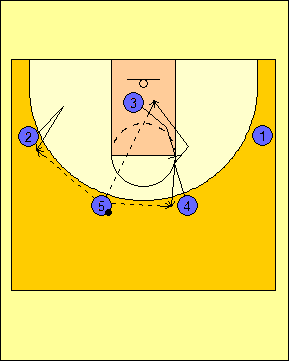
Diagram
15 |
Whenever the ball is passed to a feeder in Wildcat,
the ball-side high post will screen away for the help-side high post
(Diagram 16). This will allow us to get the ball back to the
high post if we are unable to feed the low post.

Diagram
16 |
Anytime the ball is fed to the low post, we will
look to dive the ball-side high post and fill that vacated spot with
the help-side high post (Diagram 17).
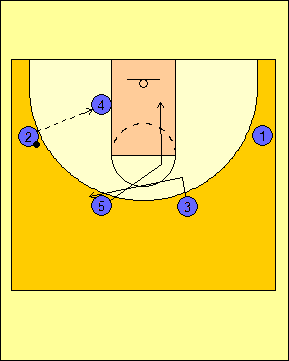
Diagram
17 |
If the ball were to be fed to the ball-side high post from the
feeder, we would look to go with a high-low entry or reverse the
ball to the dive man coming to the help-side high post (Diagram 18).
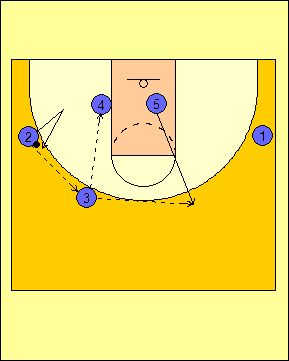
Diagram
18 |
Griffin
When I was at William Jewell College, we had a team
that was going to feature a line-up with three bigs and two guards
who could facilitate the offense without being playmakers. The
coaches at Missouri Western State University helped us by teaching
the coaching staff an offense that works similarly to "Wildcat", but
uses down screens instead of the back screen. We call this
offense "Griffin".
Diagrams 19 through 24 detail the action in Griffin.
For these notes, please refer to those made regarding Wildcat as
they are similar with the exception of the type of screen utilized
in the offense.
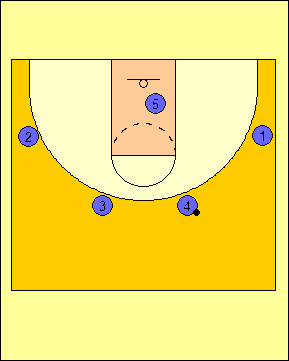
Diagram
19 |
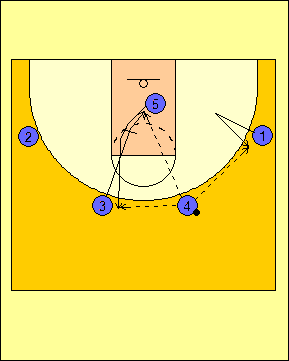
Diagram
20 |
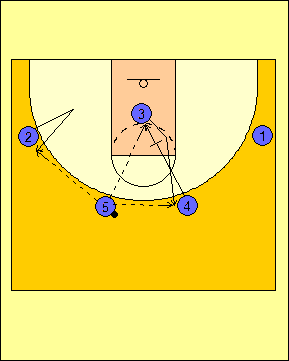
Diagram
21 |

Diagram
22 |
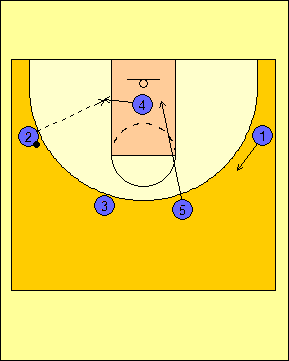
Diagram
23 |
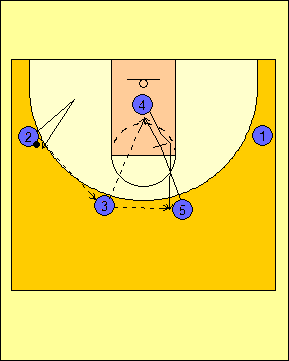
Diagram
24 |
Post Dives in "Griffin" and "Wildcat"
Whenever there is a low post feed in Griffin or
Wildcat, we have rules that we use to get the most out of a post
entry. The first pass look is to the dive man as shown in
Diagram 25. We will position the help-side feeder between the
free throw line-extended and the lane line-extended behind the three
point line so that he can get into the line of sight of the post
player with the ball.

Diagram
25 |
As much as possible, we want to get back into the
alignment so that we can run either Griffin or Wildcat.
Whenever the ball is passed out to the ball-side feeder (Diagram 26)
or the high post (Diagram 27), we will pop the dive man back high.
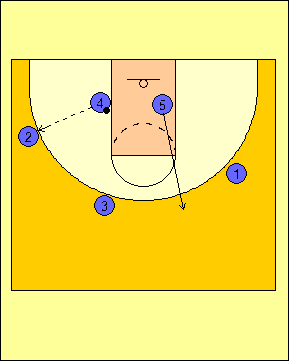
Diagram
26 |

Diagram
27 |
If the ball is passed out to the help-side feeder in
either Wildcat or Griffin, the feeder will dribble below the free
throw line-extended and look to pass into the low post (Diagram 28).
The dive man will be the post-up. Meanwhile, the remaining
high post will start to the ball then set an away screen for the low
post player who passed the ball out. This will enable us to
get back into the offensive alignment to run either Wildcat or
Griffin.

Diagram
28 |
Teaching the 2-Out/3-In Offense
The best way to start teaching either one of these three offensive systems is to
introduce it during five-on-zero. The players should know what their
responsibilities are and what they need to do to make the offense work.
You can also get more players involved and present the offense as to what it
should look like when the drills involved with it have been fully taught.
The best breakdown drills for the 2-Out/3-In Offense are
those that utilize the three big men working together. Whether you
are running from three-around-two, Wildcat, or Griffin, this is the best
breakdown drill. Start with your three big men working from the
positions they will assume within the offense you decide to use and have
them work on the options against no defenders before adding defenders.
This way, your big men will know what to do within the offense's
framework and can then bring it back to full five-on-five.
RETURN TO MEMBERSHIP AREA
© 2010-2017 Alan Peel Enterprises
|
 |